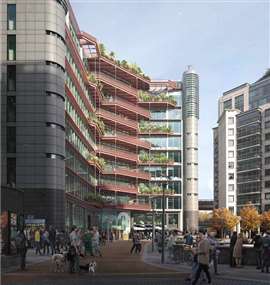Can the UK build what it plans? Ramboll MD on why certainty, skills and investment matter
24 June 2025
 Image courtesy of Ramboll
Image courtesy of Ramboll
The UK is crying out for new infrastructure.
From major clean energy and water projects to the maintenance and renewal of ageing assets, the scale of delivery required is vast.
But while the UK government’s Planning and Infrastructure Bill, its latest Spending Review, and a 10-year Infrastructure Strategy signal political intent, those measures alone will not ensure success. The construction sector itself must address a series of persistent structural issues if it is to meet these demands, Ramboll UK and Ireland managing director Neil Sansbury tells Construction Briefing.
Ramboll, a global archiecture, engineering and construction consultancy employing 18,000 people that was founded in Denmark, has grown its UK business significantly in recent years. With expertise spanning buildings, transport, energy, environment, water, and management consulting, it aims to bring its Nordic experience in sustainable development, digitalisation and modern construction methods to the UK’s infrastructure challenges.
Its strategy, branded ‘The Partner for Sustainable Change’, reflects its work across decarbonisation, green energy transition, nature-based solutions and climate resilience.
Sansbury sees clear opportunities ahead but warns that real progress will only come if industry and government jointly confront some familiar obstacles. “The ambition for growth is laudable,” he says. “The whole industry stands behind it. But challenges remain.”
The need for long-term certainty
Chief among those challenges is establishing greater predictability in the UK market. While recent policy moves have created momentum, Sansbury argues that the industry requires greater long-term clarity on spending commitments and the project pipeline to justify the significant capital investment needed.
 Neil Sansbury, managing director UK & Ireland, Ramboll (Image courtesy of Ramboll)
Neil Sansbury, managing director UK & Ireland, Ramboll (Image courtesy of Ramboll)
The 10-year-long, £725 billion Infrastructure Strategy should help in that respect, he notes. “It is a bold attempt to reverse decades of underinvestment, drive growth, and future-proof the UK’s infrastructure, providing the sector with the confidence and certainty to invest in jobs and skills,” he says.
But he adds that the success of these plans relies on effective delivery, support across the political specture, policy stability and the ability to adapt to economic and environmental challenges.
“There’s that whole stability and certainty to making sure the industry can see the certainty of spend and that we’re not going to change government again in a period of time,” he explains. “We can’t afford to flip-flop between one decision and another.”
Without that visibility, private sector investment in advanced manufacturing and construction capacity - including modern methods of construction (MMC) - remains difficult. “If you’re talking about floating wind, for example, that needs a big pipeline and a lot of certainty for people to put their hands in their pockets and make investments that are for the future,” he adds.
Unlocking delivery through MMC
For Sansbury, greater uptake of modern methods of construction (MMC) is central to improving the sector’s ability to deliver at scale. But he is clear that adoption must be strategic, targeted, and backed by demand consistency - particularly in areas where government can directly influence procurement.
Projects like the New Hospitals Programme and the Ministry of Justice’s prison construction programme, where standardisation is being pursued, offer the potential to build momentum for MMC. Education infrastructure may also lend itself to this approach. “Where we’ve got big public funds going into things, the government can influence how we design, build and construct,” he says.
However, the fragmented nature of the housing market makes MMC adoption there more difficult. Sansbury points to Denmark’s approach, where standardised prefabricated concrete elements form the backbone of much residential construction. Ramboll’s Danish teams work with architects and engineers within this system without sacrificing design flexibility. “We need to look to other places that have done it to see what we need to do to influence industry to bring them along,” he says.
Crucially, Sansbury argues for a holistic approach that involves the entire supply chain, from design through to manufacturing and construction, supported by consistent design codes and long-term pipeline commitments. “If you don’t get that throughput, you’ve got a huge asset that’s costing you a fortune,” he warns, referencing the recent collapse of several MMC housing ventures that lacked volume consistency.
Addressing the skills gap
Parallel to supply chain challenges is the ongoing shortage of skilled labour. Sansbury welcomes news that the government is committing £1.2 billion to skills and the clarity on how that money will be spent in the Infrastructure Strated. But while government-backed schemes to bring new entrants into the sector are welcome, they will not meet demand alone he notes. The Construction Industry Training Board has estimated that an additional 250,000 workers will be required in the UK by 2028.
Sansbury emphasises the need to change perceptions of the industry among young people and broaden awareness of the range of roles available. “It’s not just about bricklaying or plumbing. There are all sorts of innovative roles. We’re recruiting engineers who come in with coding abilities because that’s the way we’ll be designing things in future,” he says. Technologies such as digital twins and data-driven design are reshaping the profession, and the industry must promote this evolution to attract talent.
Ramboll, for its part, continues to invest in developing its workforce. It is a member of the 5% Club and actively recruits apprentices and graduates to build its talent pipeline. “For me, it’s about continuing to maintain Ramboll as a great place to work, while also driving the capabilities our clients need,” he says.
 Ramboll was involved in the renovation of the 10-storey 3 Sheldon Square in London, UK. Ramboll secured Ramboll secured a BREEAM Outstanding rating, WELL Building Standard precertification, and a Wired Score Gold on the two-decade-old building. Its steel frame, concrete floor slabs and shaft walls were all retained (Image: Morris+Company and British Land)
Ramboll was involved in the renovation of the 10-storey 3 Sheldon Square in London, UK. Ramboll secured Ramboll secured a BREEAM Outstanding rating, WELL Building Standard precertification, and a Wired Score Gold on the two-decade-old building. Its steel frame, concrete floor slabs and shaft walls were all retained (Image: Morris+Company and British Land)
Financing the delivery gap
Even with better planning, supply chain improvements and skills investment, the question of how to fund large-scale infrastructure remains. Public finances alone are unlikely to be sufficient, Sansbury argues, and new models of private finance will be required.
While controversial, the potential return of private finance initiatives (PFI) - or at least updated versions - is now being openly discussed in the sector. Sansbury highlights models like the Competitively Appointed Providers (CAP) used in the water industry, which combine design, build, operate and finance arrangements. “That’s one way of doing big chunks of infrastructure which seems to be working successfully,” he says.
For smaller assets like hospitals and prisons, he believes lessons can be drawn from past PFI projects while addressing previous failings. “We’ve had 25 or 30 years of PFI now. We should be able to take those learnings and build them into how we do things,” he says. Key to success, he stresses, is sensible risk allocation. “Risk should sit where the individual is best placed to manage it, rather than just pushing it all onto the private sector.”
Building on existing work instead of reinventing the wheel
While the challenges are significant, Sansbury does not believe they require fundamentally new solutions. Instead, he advocates revisiting the many recommendations already produced in recent years. “Innovation doesn’t have to be about brand new thinking all the time,” he says. “There’s stuff that’s been thought through and is on the table, but we’ve done not a great deal with it. We need to look at why that hasn’t happened, and what we can do to drive it forward.”
He points to the role of bodies like the Construction Leadership Council (CLC) and the value of ongoing dialogue between government and industry. “We just need to continue these conversations, continue to get the industry together and look at how we can solve the challenges,” he says.
 Ramboll was involved in the construction of The British Antarctic Survey’s (BAS) new scientific support and operations facility, the Discovery Building, at Rothera Research Station in Antarctica (Image courtesy of British Antarctic Survey)
Ramboll was involved in the construction of The British Antarctic Survey’s (BAS) new scientific support and operations facility, the Discovery Building, at Rothera Research Station in Antarctica (Image courtesy of British Antarctic Survey)
Learning from the Nordics
As Ramboll looks to the future, Sansbury sees clear opportunities to apply lessons from the company’s Nordic roots. Projects such as Copenhagen’s Nordhavn regeneration - a “five-minute city” scheme transforming a former industrial port - demonstrate how integrated master planning, smart mobility and resilient design can deliver liveable, sustainable communities at scale.
The company is already supporting similar work with the Scottish government on 20-minute neighbourhoods and advising on flood resilience and climate adaptation projects. “There are things we can take from our heritage and bring into what we’re doing in the UK,” Sansbury says.
For the UK to realise its infrastructure ambitions, industry and government must now focus on turning well-rehearsed plans into reality. The tools exist, Sansbury argues. The task ahead is to apply them with consistency, coordination and commitment.
STAY CONNECTED



Receive the information you need when you need it through our world-leading magazines, newsletters and daily briefings.
CONNECT WITH THE TEAM








